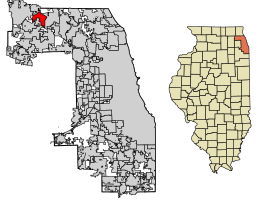
Lake Helen is a city in Volusia County, Florida, United States. It is part of the Deltona–Daytona Beach–Ormond Beach, Florida Metropolitan Statistical Area. The population was 2,842 at the 2020 census.

Barrington Hills is a village located about 40 miles (64 km) northwest of Chicago in the U.S. state of Illinois. Per the 2020 census, the population was 4,114. It straddles approximately 29 square miles (75 km2) over four counties, Cook, Kane, Lake, and McHenry. The Village of Barrington Hills was incorporated in 1957.
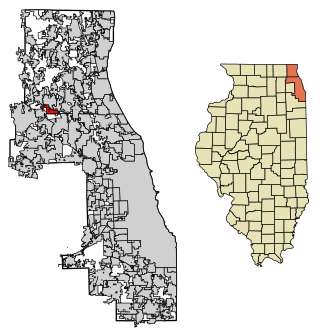
Deer Park is a village in Lake and Cook Counties, Illinois. Per the 2020 census, the population was 3,681. The village is one of the few left in the Chicago area that enjoy a green belt which is bordered by two large natural areas providing outdoor recreation and open space. The village is home to popular shopping and dining destinations: Deer Park Town Center and the Town Center Promenade. The town is also home to the Vehe Farm, an Illinois Centennial Farm.

Lansing is a village in Cook County, Illinois, United States. Lansing is a south suburb of Chicago. The population was 29,076 at the 2020 census.

Orland Hills is a village in Cook County, Illinois, United States. Per the 2020 census, the population was 6,893.

Streamwood is a village in Cook County, Illinois, United States. Per the 2020 census, the population was 39,577. It is a northwest suburb of Chicago, and is a part of the Chicago metropolitan area.
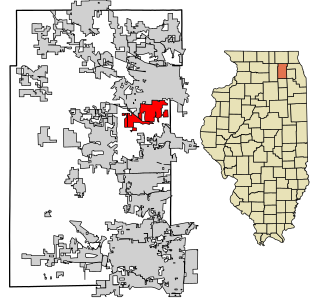
South Elgin is a village in Kane County, Illinois, United States. Per the 2020 census, the population was 23,865. In 2007, Money magazine named South Elgin as 82nd of 100 entries in its "America's Best Places to Live" edition and again in 2011 as 98th of 100 entries.
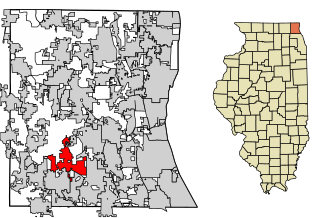
Hawthorn Woods is a village in Fremont and Ela townships in Lake County, Illinois, United States. Per the 2020 census, the population was 9,062. The village is located approximately 40 miles (60 km) northwest of downtown Chicago. Hawthorn Woods was officially incorporated in 1958. Major transportation arteries include Midlothian Road, Old McHenry Road, Algonquin Road, Half Day Road, and the Elgin, Joliet and Eastern Railway. Hawthorn Woods Country Club, whose golf course was designed by golf professional Arnold Palmer, is located within the village's perimeter.

Round Lake Heights is a village in Lake County, Illinois, United States. Per the 2020 census, the population was 2,622.

Round Lake Park is a village in Lake County, Illinois, United States. Per the 2020 census, the population was 7,680. It is located along the south side of the lake, Round Lake. Access to the lake from this town is private and only for residents of Round Lake Park.

Volo is a village in Lake County, Illinois, United States. It was incorporated as a village on April 26, 1993. Per the 2020 census, the population was 6,122.

Madison is a city in Madison and St. Clair counties in the U.S. state of Illinois. The population was 3,171 at the 2020 census, down from 3,891 in 2010. It is home to World Wide Technology Raceway at Gateway and the first Bulgarian Orthodox church in the United States.

Holiday Hills is a village in McHenry County, Illinois, United States. Per the 2020 census, the population was 618.

The Village of Lakewood is a village in McHenry County, Illinois, United States. It was incorporated as a village on July 10, 1933. Per the 2020 census, the population was 4,283. Although commonly referred to as Lakewood, the town's proper name is preceded by 'The Village of'.

Prairie Grove is a village in McHenry County, Illinois, United States, first incorporated in 1973. Per the 2020 census, the population was 1,963.

Spring Grove is a village in McHenry County. Portions of unincorporated Lake County, Illinois also utilize Spring Grove postal addresses. It is a commuter village within the Chicago metropolitan area. Per the 2020 census, the population was 5,487. It is also home to Chain O'Lakes State Park.

Union is a village in McHenry County, Illinois, United States. The population was 551 at the 2020 census.
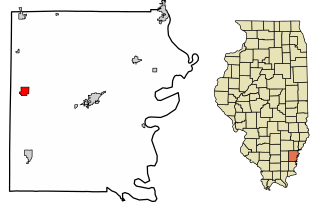
Enfield is a village in White County, Illinois, United States. The population was 596 at the 2010 census, which rose to 794 in the 2020 Census.

Twining is a village in Arenac County of the U.S. state of Michigan. The population was 130 at the 2020 census. The village is situated on the boundary between Mason Township on the west and Turner Township on the east, with about half of the village in each.

Tower Lakes is a village in Lake County, Illinois, United States. Per the 2020 census, the population was 1,226.
